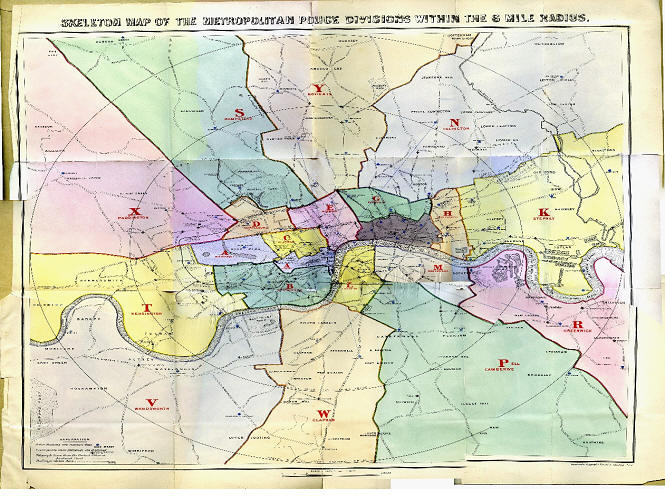
Metropolitan Police Divisions 1860s
Divisions in 1860s 1880-1896 1903-1920 1921-1929 1931-1933 1946-1958 1965 1985-1986 1993-1994 2000 2018-2019
Walham Green became known as Fulham from June 1863 and is shown on V Division.
Police Orders of 11 January 1864 showed Greenford as part of T Division.
Notting Hill was policed by T Division
Walton Street was on B Division
October 1865 reorganisation
In Police Orders of 28 October 1865, a reorganisation of Divisions was announced, with the formation of three new Divisions, W Clapham, X Paddington, and Y Highgate. The areas covered were distinguished as ‘Interior Districts’ and ‘Exterior Districts’ for many Divisions, which continued to be commanded by a Superintendent.
At this stage A Division remained as Whitehall, with B Division still known as Westminster. The early station at Milman’s Row, Word’s End, Chelsea was now shown on T (Kensington) rather than V (Wandsworth):
|
A Whitehall* |
King Street, Hyde Park, Wellington Arch |
|
B Westminster* |
Rochester Row, Cottage Road, Walton Street |
|
C St James* |
Vine Street, Marlborough Mews |
|
D Marylebone* |
Marylebone Lane, Molyneux Street. |
|
E Holborn* |
Bow Street (from 1869), Hunter Street, George Street Bloomsbury (later Tottenham Court Road) |
|
F Covent Garden |
F Division was amalgamated with E Division in October 1869 and became F (Paddington) in April 1886. |
|
G Finsbury* |
Kings Cross Road, Old Street |
|
H Whitechapel* |
Leman Street, Church Street Shoreditch, Commercial Street from 1876 |
|
K Stepney |
Arbour Square, Shadwell, Poplar, Bethnal Green, Limehouse (from 1879), Isle of Dogs, Bow, West Ham, Barking Road Plaistow, Barking, Ilford, Dagenham, Chadwell Heath, Barkingside, East Ham and Chigwell (last four being Sergeants’ houses only; Chigwell supervised from K but formally part of N Division). |
|
L Lambeth* |
Kennington Lane, Tower Street [sic], Kennington Road (from 1874) |
|
M Southwark* |
Southwark, Bermondsey |
|
N Islington |
Islington, Hoxton, Kingsland, Hackney, Walthamstow, Waltham Abbey, Loughton, Woodford, Wanstead, and Chigwell. |
|
P Camberwell |
Camberwell, Walworth / Carter Street, Rodney Road (from 1873), Peckham, Dulwich, Norwood (Gipsy Hill), Sydenham, Lewisham, Beckenham, Bromley, Farnborough |
|
R Greenwich |
Blackheath Road, Deptford, Woolwich, East Greenwich/Park Row), Rotherhithe, Shooters Hill (formerly Old Dover Road), Bexley, Erith, Lee, Eltham, Sidcup, St Mary Cray. |
|
S Hampstead |
Albany Street, Portland Town (later St John’s Wood), Hampstead, Whetstone, Barnet, Mimms, Shenley, Hendon, Edgware, Bushey |
|
T Kensington |
Kensington, Hammersmith, Chelsea, Fulham, Chiswick, Ealing (transferred to X December 1865), Brentford, Hounslow, Harlington, Staines, Sunbury, Hampton, Twickenham, Isleworth, Heston (later Norwood Green) |
|
V Wandsworth |
Wandsworth, Battersea, Merton, Barnes, Richmond, Kingston, Ditton, Epsom, Hampton Court Palace, Kew Gardens |
|
W Clapham (new Division) |
Clapham, Brixton, Streatham, Croydon, Sanderstead, Carshalton, Mitcham, Sutton, Banstead, Tooting |
|
X Paddington (new Division) |
Paddington, Notting Hill, Notting Dale (from 1868), Harrow Road, Acton, Hanwell, Hillingdon, Harefield, Harrow, Willesden (later Harlesden), Greenford, Ruislip |
|
Y Highgate (new Division) |
Highgate, Somers Town, Kentish Town, Caledonian Road, Tottenham, Hornsey (from N Division), Southgate, Enfield Town, Enfield Highway (later Ponders End), Edmonton, Cheshunt, Holloway new police station from 1874 |
|
*Details from reading of Stanford’s skeleton map (below) rather than 1865 Police Order. |
|

1869
In February 1869 Sir Edmund Henderson was appointed Commissioner to replace Sir Richard Mayne who had died in office. Two weeks later, Police Orders of 27 February 1869 announced that the Divisions of the Metropolitan Police District were divided into four Districts, each being under the command of a newly-created post of District Superintendent, later titled District Officer, and then Chief Constable. The arrangement was partly in response to an Inquiry into the 1867 bomb explosion at Clerkenwell prison and was intended to improve communication and delegation from Commissioner Sir Richard Mayne. At the same time the rank of Chief Superintendent, used for the command of A Division, was abolished (PO 27 February 1869). Adolphus Williamson would be appointed Chief Constable CID in 1886, the same year as District Superintendents were re-graded as Chief Constables (PO 27 October 1886).
|
No 1 District |
G H K N and Thames |
|
No 2 District |
D E S X Y |
|
No 3 District |
A B C F T V |
|
No 4 District |
L M P R W |
At this time it was common for the Commissioner to be called ‘Chief Commissioner’. The other Commissioners, Captain William Hay and Lt Colonel Douglas Labalmondière each took responsibility for two of the Districts.
Police Orders of 13 March 1869 announced that Inspector Thomson from A Division would take responsibility for both E and F Divisions, with F transferred from No 3 to No 2 District at the same time. The two Divisions were then amalgamated Police Orders of 7 October 1869). Bow Street became the main station of E (Holborn) Division, and F Division effectively lapsed. A map produced by Stanfords, possibly around 1871, illustrated the new Divisions within a six-mile radius from Charing Cross, including police stations, fixed points where police officers could be found, and telegraph connections. The map reflects the facts that there was no F Division from October 1869 until April 1886.
Divisions in 1860s 1880-1896 1903-1920 1921-1929 1931-1933 1946-1958 1965 1985-1986 1993-1994 2000 2018-2019